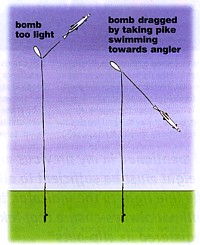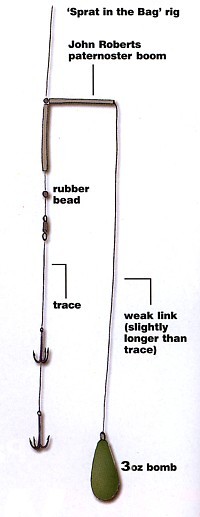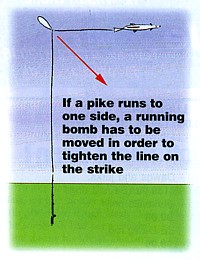Despite
having written a book detailing numerous pike rigs the number that I use is actually
fairly limited. The main thing I look for in a rig is simplicity. The less stuff
you use to make a rig up, the less chance of it becoming a rat's nest of tangled
line when you cast it out. Every part of a rig should be there for a purpose.
If it doesn't have a useful function get rid of it.
Floatless
running legers have been the staple of my deadbaiting set ups for as long as I
can remember, and the legered deadbait, in one form or another, must be the most
widely use pike fishing method in the UK. Even so, the mechanics of its use don't
seem to be widely understood. I mentioned in my previous article that the weight
must be sufficient to allow you to get the line tight to the indicator, but this
alone will not always ensure that takes are registered as clip outs.
 Too
light a running bomb can be dragged across a smooth lake bed. The degree to which
this can occur will depend on how tightly you have the line clip adjusted. If
flow or undertow is severe then the clip may have to be quite tightly set. In
extreme cases a pike can pick up a deadbait and move directly towards you without
any indication at the rod. The pulley effect of a free running lead means that
an indication will only occur when the pike starts to move away from the angler,
and it will, perhaps surprisingly, then give you a slack line indication. By using
a bomb upwards of two ounces in weight the likelihood of a pike dragging them
across a lake bed is reduced.
Too
light a running bomb can be dragged across a smooth lake bed. The degree to which
this can occur will depend on how tightly you have the line clip adjusted. If
flow or undertow is severe then the clip may have to be quite tightly set. In
extreme cases a pike can pick up a deadbait and move directly towards you without
any indication at the rod. The pulley effect of a free running lead means that
an indication will only occur when the pike starts to move away from the angler,
and it will, perhaps surprisingly, then give you a slack line indication. By using
a bomb upwards of two ounces in weight the likelihood of a pike dragging them
across a lake bed is reduced.
Another
time you will get a slack line bite when employing a running leger is if the rig
has tangled during the cast. So the second most important feature of a running
leger rig is its resistance to tangling. As ever, the best way to avoid tangles
is to keep the rig simple. My basic set up comprises of a Roberts Low Resistance
Leger Ring on the line, stopped at the trace by a tulip bead. As I sleeve all
my traces with shrink tube at the swivel connection, this semi-stiff tube acts
as a boom and seems to prevent the trace and bomb tangling on the cast. A hooked
snap link on the Leger Ring for attaching the bomb of my choice completes the
set up.
My
mate Nige Grassby had problems on one water he was fishing that involved lobbing
deadbaits under bushes overhanging the water. On almost every cast the bait was
tangling with the main line above the bomb. The solution was to put a length of
flexible boom tube above the lead. This can be attached to the tulip bead on a
running rig, allowing the Leger Ring to remain free sliding. Using one of the
armoured rig tubes that are available would also give you some degree of bite-off
protection too, should the rig still get tangled (which it can) without you noticing
it. How tooth proof these tubes are I can't say, but anything is better than nothing
if you feel you have to try and eliminate bite-offs altogether. In practice I
think bite-offs on deadbait rigs are something that only happens once in every
other blue moon. So long as you wind in to check any time you think a rig might
be tangled on the cast I can't see bite-offs being a worry in the real world.
When
it comes to attaching leads to rigs I am quite happy to clip them directly to
the Leger Ring in snag free conditions. However, I was chatting to Lake District
regular Steve Hincks a while back and he said he always uses a weak link, which
reminded me that when I fished the Cumbrian lakes every week I did too. The problems
with weak links are that they can tangle, and if using larger bombs they can snap
on the cast too. To keep tangles to a minimum make the links as short as possible,
and sleeve them in silicone tubing. My preference is for a Leger Ring at one end
and a snap link at the other end of a length of ten pound nylon mono. So long
as your main line is at least half as strong again as the weak link, it will be
the link that gives way in the event that the lead snags up on the retrieve. The
silicone sleeve should leave just the opening part of the snap link uncovered.
 The
way I make my links up is to tie the mono to the Leger Ring with a blood knot
and form a loop knot in the other end. Attach the snap link to the loop, and cut
some silicone tube to the precise length of the link. Take a piece of heavy mono,
thread it through the tube, through the snap link, and back through the tube.
Then pull the weak link through the tube until the snap appears. This makes a
neat tangle resistant weak link. The length of this link can vary to suit where
you are fishing. As short links tangles least, most of mine are around the two
to three inch length. But, if fishing over weedy bottoms you can use longer links,
and even thread a one inch poly ball onto a link. In practice I believe that,
even with poly balls, long links will be dragged into the weed by the action of
tightening the line to set the indicator, but it should rise up when the line
is pulled out of the indicator and the run is in progress.
The
way I make my links up is to tie the mono to the Leger Ring with a blood knot
and form a loop knot in the other end. Attach the snap link to the loop, and cut
some silicone tube to the precise length of the link. Take a piece of heavy mono,
thread it through the tube, through the snap link, and back through the tube.
Then pull the weak link through the tube until the snap appears. This makes a
neat tangle resistant weak link. The length of this link can vary to suit where
you are fishing. As short links tangles least, most of mine are around the two
to three inch length. But, if fishing over weedy bottoms you can use longer links,
and even thread a one inch poly ball onto a link. In practice I believe that,
even with poly balls, long links will be dragged into the weed by the action of
tightening the line to set the indicator, but it should rise up when the line
is pulled out of the indicator and the run is in progress.
 Of
course, if you are aiming for ultimate long range casts with large leads a weak
link is going to result in the lead cracking off. Over snag-free ground the weak
link can be dispensed with, but if you need one another rig has to be used. I
have written about the 'Sprat in the Bag Rig' before, but it is worth covering
again. For this rig the Leger Ring is replaced by a Roberts Paternoster Boom,
and the tulip bead can be swapped for a plain old rubber bead. A length of weak
nylon is tied to the eye of the Paternoster Boom and a loop formed in the other
end of the weak link at a point that allows the chosen weight to hang slightly
below the (small) deadbait attached to the hooks. Now you place both the bomb
and the bait in a PVA bag, squeezing the air out of the bag and twisting the open
end which can be moistened to seal it, or tied up with some PVA string. Blast
the whole lot with freezer spray to prevent premature melting of the bag, and
the weight of the bomb should now be carried by the trace, and not the weak link
enabling you to whack the whole lot to the horizon.
Of
course, if you are aiming for ultimate long range casts with large leads a weak
link is going to result in the lead cracking off. Over snag-free ground the weak
link can be dispensed with, but if you need one another rig has to be used. I
have written about the 'Sprat in the Bag Rig' before, but it is worth covering
again. For this rig the Leger Ring is replaced by a Roberts Paternoster Boom,
and the tulip bead can be swapped for a plain old rubber bead. A length of weak
nylon is tied to the eye of the Paternoster Boom and a loop formed in the other
end of the weak link at a point that allows the chosen weight to hang slightly
below the (small) deadbait attached to the hooks. Now you place both the bomb
and the bait in a PVA bag, squeezing the air out of the bag and twisting the open
end which can be moistened to seal it, or tied up with some PVA string. Blast
the whole lot with freezer spray to prevent premature melting of the bag, and
the weight of the bomb should now be carried by the trace, and not the weak link
enabling you to whack the whole lot to the horizon.
.jpg) Once
the rig has settled it will take a few moments for the bag to melt, exactly how
long will depend on the water temperature, so you might tighten down to the rig
and attach your drop-back indicator immediately, only to find that some slack
line develops after a minute or so. This slack is created when the bag has melted.
Reset the indicator and you are back in business. Leads of three ounces can safely
be used with this rig without cracking off, and yet giving you the advantage of
a weak lead link should the bomb snag up.
Once
the rig has settled it will take a few moments for the bag to melt, exactly how
long will depend on the water temperature, so you might tighten down to the rig
and attach your drop-back indicator immediately, only to find that some slack
line develops after a minute or so. This slack is created when the bag has melted.
Reset the indicator and you are back in business. Leads of three ounces can safely
be used with this rig without cracking off, and yet giving you the advantage of
a weak lead link should the bomb snag up.
Those,
then, are the two basic running leger rigs that I use. The overriding principle
behind them is that they should offer a pike no resistance when it is running
with the bait. I am convinced that it is changes in resistance that cause dropped
runs, once the pike is moving off with the bait. Now while it might seem that
a running leger always offers this ideal, there are situations where a running
leger can cause problems. Admittedly they arise when you come to set the hooks
rather than while the run is in progress, but they can result in lost fish, and
are caused by the very nature of the rigs that makes them give such good bite
indication.
 Because
the bomb is heavy enough to remain in place as a pike pulls line from an open
spool this can, if the pike swims off to left or right, create an angle in the
line between angler and fish. The problem that is created is one of making contact
with the pike as you wind down to pull the hooks home. If the lake bed is clean
and snag free then a steady winding down to the fish should keep an even pressure
on the line as the bomb moves and enable a firm strike to be made. However, there
will be times when the bomb doesn't move steadily and smoothly, or drags into
weed as you take the angle out of the line, and at this point you are in trouble.
The pike might eject the bait at this point, or, more likely, you will not be
able to get tight enough to the fish to set the hooks. Most probably you will
fail to hook the fish, although you might feel it 'on' for a second. In a worst
case scenario the bomb may in fact become lodged and immovable.
Because
the bomb is heavy enough to remain in place as a pike pulls line from an open
spool this can, if the pike swims off to left or right, create an angle in the
line between angler and fish. The problem that is created is one of making contact
with the pike as you wind down to pull the hooks home. If the lake bed is clean
and snag free then a steady winding down to the fish should keep an even pressure
on the line as the bomb moves and enable a firm strike to be made. However, there
will be times when the bomb doesn't move steadily and smoothly, or drags into
weed as you take the angle out of the line, and at this point you are in trouble.
The pike might eject the bait at this point, or, more likely, you will not be
able to get tight enough to the fish to set the hooks. Most probably you will
fail to hook the fish, although you might feel it 'on' for a second. In a worst
case scenario the bomb may in fact become lodged and immovable.
This
is probably less of a concern if fishing with braid as your mainline, but it still
needs to be borne in mind. It was failing to hook a pike that had run to one side
against a snagged bomb that caused me to reject the Bellars/Dyson style running
paternoster, and latterly has lead me to use semi-fixed lead rigs for most of
my deadbait legering in recent times. More of which in part
three of this series.



